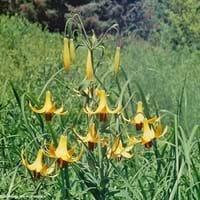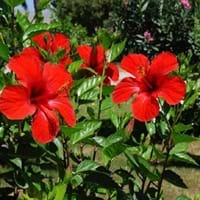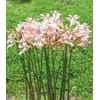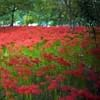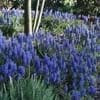Life Span
Perennial
Annual and Perennial
Type
Bulb or Corm or Tuber
Broadleaf Evergreen
Origin
Hybrid origin, North America, Europe, Africa, Asia
China
Types
Tiger lily, Columbia lily, Woody lily
Not Available
Habitat
meadows, Shady Edge, Woods
gardens, Grassland, Homesteads, Subtropical climates, tropical environments
USDA Hardiness Zone
2-8
9-15
AHS Heat Zone
8-1
Not Available
Habit
Upright/Erect
Oval or Rounded
Flower Color
White, Yellow, Red, Green, Purple, Gold, Pink, Rose, Peach, Burgundy, Bronze
Yellow, Red, Dark Red
Flower Color Modifier
Bicolor
Bicolor
Fruit Color
Yellow green, Sandy Brown
Not Available
Leaf Color in Spring
Green, Dark Green
Dark Green
Leaf Color in Summer
Light Green
Dark Green
Leaf Color in Fall
Several shades of Green
Dark Green
Leaf Color in Winter
Light Green
Dark Green
Leaf Shape
Long Narrow
Ovate
Plant Season
Spring, Summer, Fall
Spring, Summer, Fall, Winter
Sunlight
Full Sun, Partial Sun, Partial shade
Full Sun, Partial Sun
Growth Rate
Medium
Medium
Type of Soil
Clay, Loam, Sand
Loam
The pH of Soil
Acidic, Neutral, Alkaline
Neutral
Soil Drainage
Well drained
Well drained
Bloom Time
Not Available
Early Summer, Summer, Late Summer, Early Fall, Fall, Indeterminate
Tolerances
Drought
Drought, Variety of soil types
Where to Plant?
Container, Ground
Ground, Pot
How to Plant?
From bulbs, Seedlings, Transplanting
Stem Cutting, Tip cutting, Vegetative Reproduction
Plant Maintenance
Medium
Medium
Watering Requirements
Average Water Needs, Never Over-water, Requires regular watering
It cannot sustain wet-feet, Keep the Soil well drained, Requires watering in the growing season, Water Deeply, Water frequently while growing, Water more in summer, Water when soil is dry
In Summer
Lots of watering
Lots of watering
In Spring
Moderate
Moderate
In Winter
Average Water
Average Water
Soil pH
Acidic, Neutral, Alkaline
Neutral
Soil Type
Clay, Loam, Sand
Loam
Soil Drainage Capacity
Well drained
Well drained
Sun Exposure
Full Sun, Partial Sun, Partial shade
Full Sun, Partial Sun
Pruning
Remove damaged leaves, Remove dead leaves, Remove dead or diseased plant parts
A hard prune may be necessary if the plant becomes woody, Cut leaves after fall, Cut or pinch the stems, Pinch or prune as they grow to promote branching and bushiness, Prune for shortening long shoots, Prune in early summer, Remove deadheads
Fertilizers
All-Purpose Liquid Fertilizer
Apply 10-10-10 amount, Balanced liquid fertilizer, Do not fertilize new plants until at least a month, Use a low phosphate fertilizer to improve the quality of the blooms
Pests and Diseases
Red blotch
Aphids, Mealybugs, Red spider mite, Scale, Thripes, Whiteflies
Plant Tolerance
Drought
Drought, Variety of soil types
Flower Petal Number
Single
Single
Foliage Texture
Not Available
Medium
Foliage Sheen
Not Available
Glossy
Attracts
Deers, Insects, Moths
Bees, Butterflies, Hummingbirds
Allergy
Headache
no allergic reactions
Aesthetic Uses
Beautification, Bouquets, Landscape Designing, Showy Purposes
Beautification, Borders, Landscape Designing
Beauty Benefits
Not Available
Hair Conditioner, Not Available, Prevents greying of hair, Prevents Premature Baldness, Promotes Healthy Hair, Promotes healthy skin, Speed hair growth
Environmental Uses
Air purification
Air purification
Medicinal Uses
Cough, Fever, Menstrual Disorders, Stomach pain, tuberculosis, Upset stomach, Wounds
anti-inflammatory, Diuretic, Hair Loss, High blood pressure, Vitamin C
Part of Plant Used
Bulbs, Flowers, Root, Seeds
Flowers, Leaf Stalks, Leaves
Other Uses
Can be made into a herbal tea, Employed in herbal medicine, Used As Food
Culinary use, Employed in herbal medicine, Jam, Jelly, Making Shampoo, Oil is used for aromatherapy, Oil is used in perfume, soaps, creams, etc., Showy Purposes, Traditional medicine, Use in Chinese herbology, Used As Food, Used as Ornamental plant, Used for bedding in gardens, Used for fragrance, Used for its medicinal properties, Used in making beverages, Used in paper industry, Used in salads, Used to make hair tonic
Used As Indoor Plant
Yes
No
Used As Outdoor Plant
Yes
Yes
Garden Design
Alpine, Container, Cutflower, Feature Plant, Mixed Border, Wildflower
Container, Foundation, Houseplant, Mixed Border, Tropical
Botanical Name
LILIUM canadense
HIBISCUS rosa-sinensis 'Lillikoi Yellow'
Common Name
Meadow lily
China rose
In Hindi
कनाडा लिली
गुड़हल, जवा कुसुम
In German
Kanada Lily
Tropical Hibiscus
In French
Lily Canada
Hibiscus Tropical
In Spanish
Kanada Lily
hibisco tropical
In Greek
Kanada Lily
τροπική Hibiscus
In Portuguese
Kanada Lily
Hibiscus tropical
In Polish
Kanada Lily
Tropical Hibiscus
In Latin
Canada Lily
Tropical Hibiscus
Phylum
Magnoliophyta
Magnoliophyta
Class
Liliopsida
Magnoliopsida
Family
Liliaceae
Malvaceae
Clade
Angiosperms, Monocots
Angiosperms, Eudicots, Rosids
Subfamily
Lilioideae
Malvoideae
Number of Species
Not Available
Importance of Canada Lily and Chinese hibiscus
Want to have the most appropriate plant for your garden? You might want to know the importance of Canada Lily and Chinese hibiscus. Basically, these two plants vary in many aspects. Compare Canada Lily and Chinese hibiscus as they differ in many characteristics such as their life, care, benefits, facts, etc. Every gardener must at least have the slightest clue about the plants he wants to plant in his garden. Compare their benefits, which differ in many ways like facts and uses. The medicinal use of Canada Lily is Cough, Fever, Menstrual Disorders, Stomach pain, tuberculosis, Upset stomach and Wounds whereas of Chinese hibiscus is anti-inflammatory, Diuretic, Hair Loss, High blood pressure and Vitamin C. Canada Lily has beauty benefits as follows: Not Available while Chinese hibiscus has beauty benefits as follows: Not Available.
Compare Facts of Canada Lily vs Chinese hibiscus
How to choose the best garden plant for your garden depending upon its facts? Here garden plant comparison will help you to solve this query. Compare the facts of Canada Lily vs Chinese hibiscus and know which one to choose. As garden plants have benefits and other uses, allergy is also a major drawback of plants for some people. Allergic reactions of Canada Lily are Headache whereas of Chinese hibiscus have no allergic reactions respectively. Having a fruit bearing plant in your garden can be a plus point of your garden. Canada Lily has no showy fruits and Chinese hibiscus has no showy fruits. Also Canada Lily is not flowering and Chinese hibiscus is not flowering . You can compare Canada Lily and Chinese hibiscus facts and facts of other plants too.
